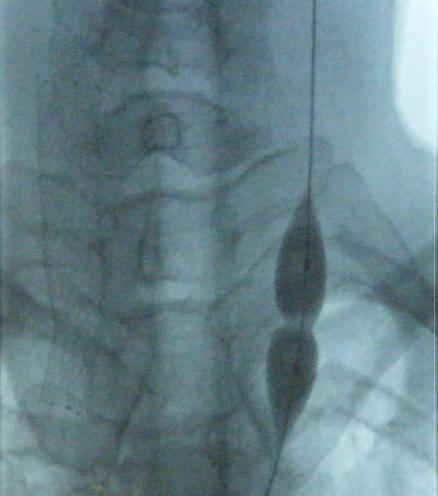
Balloon dilation of a stenosed jugular vein, the “liberation procedure” wrongly promoted as treating multiple sclerosis.
In 2009 CCSVI was proposed by Italian vascular surgeon, Dr. Paolo Zamboni – that multiple sclerosis (MS) is caused by chronic blockage of the veins that drain the brain. Since that time we have seen the evolution of a medical pseudoscience. It has been a fascinating case study in how science sorts out what works and what doesn’t, and how patients, believers, and the public react to this information. The story is ongoing and there are some interesting updates.
Background on CCSVI
CCSVI stands for chronic cerebrospinal venous insufficiency. Zamboni believes that blockages in the veins that drain blood from the brain cause back pressure in the brain, decreasing blood flow and leading to secondary inflammation, and further that this results in the clinical diseases we collectively known as MS. Zamboni’s interest in MS is not random. His wife has MS, and it is interesting that he is a vascular surgeon and found what he believes is a cause of MS that can be treated by vascular surgeons. This does not mean his ideas are wrong, it just means he has a clear bias and his data needs to be looked at carefully and independently replicated.
His initial study found that 100% of the patients he examined with MS had cranial venous blockage. That is also curious. We rarely find 100% correlations in medicine, even for solid theories. It is a huge red flag for systematic bias.
The MS community was appropriately skeptical. While the exact cause of MS remains unknown, we have been studying it for decades and there is a lot we do know. We know, for example, that MS is primarily an autoimmune disease, and the pathology is largely caused by inflammation. We now, in fact, have a long list of effective treatments for some types of MS that suppress the immune system and inflammation. There are still some types, such as chronic progressive MS, that do not respond to the best treatments.
The idea that MS was caused by vascular blockage was therefore a radical idea that flew in the face of existing research. Occasionally, however, radical ideas turn out to be true, and so some MS researchers set out to test Zamboni’s hypothesis.
Meanwhile, the community of MS patients were extremely interested in this new hypothesis. To them Zamboni’s claims meant hope, especially for the most desperate patients who are not responding to available treatments. Before the basic claim that MS correlates with CCSVI was proven, some doctors (notably in Canada) began treating this hypothetical cause by opening the blocked veins in what became known as the liberation procedure. Many patients wanted this procedure, either open label or experimentally, even though it was unproven.
In an ideal world Zamboni’s new and radical hypothesis would have been objectively tested and replicated, and over the next few years it would either gather support or wither under negative evidence. That is, in fact, what happened within the scientific community – studies failed to replicate Zamboni’s findings, and the hypothesis was essentially disproved.
The largest study was conducted in 2013, involving 1,767 subjects, with either MS, other neurological disease, or healthy controls. They used ultrasound to examine the patients’ blood vessels and found zero correlation between blockage and MS. Another smaller 2013 study involving 177 subjects also used a dye venogram, which is the gold standard, and again found no correlation at all. These two studies signaled the scientific death of the CCSVI hypothesis. It was completely dead at this point. Previously the evidence was mixed but mostly negative, and now it was devastatingly negative.
This should have been the end of the story, but of course the story did not end there, because we do not live in an ideal world.
Recent activity
There continues to be legitimate research into CCSVI, not because it is of scientific interest but because of continued public interest. A 2016 study found no difference in the venous drainage pattern between MS patients and healthy controls. Another 2016 study used “Four-dimensional flow magnetic resonance imaging” and again found no difference between MS patients and controls. Yet another 2016 study found no correlation between CCSVI and MS.
These were all after a 2015 review which concluded that the link between CCSVI and MS was a “failed concept.”
Meanwhile, Zamboni has not conceded the failure of his hypothesis. There is nothing wrong with coming up with a new and even radical idea in medicine. That is the raw material for scientific investigation. It is unacceptable, however, to refuse to abandon your hypothesis in the face of overwhelmingly negative evidence. That is when you pass from the realm of mainstream science into the realm of the crank. In medicine this has direct implications for patients, and therefore there is also a significant ethical dimension.
Also in 2016 Zamboni published another study in which he claims that:
Fixing the flow in the jugulars in patients with chronic cerebrospinal venous insufficiency might significantly reduce brain ventricle volume and improve cerebral perfusion. These changes are more evident in patients in the earlier stages of neurodegenerative disease.
This is a common pattern that we see in many dubious health claims. The first scientific priority is to test the basic claim itself – is there a real correlation between venous blockage and MS? Until that question is settled, asking subsidiary questions is mostly a waste of time and resources. We often find that proponents of “alternative” or dubious claims fail to do this. Rather, they tend to nibble around the edges, doing research that does not address the core question but assumes the core claim and asks tangential questions.
Harriet Hall compared this to Tooth Fairy science. This is like doing research characterizing the amount of money left by the Tooth Fairy, and the relationship between tooth characteristics and money left, but failing to ask the core question – is the Tooth Fairy real?
Zamboni is moving into the realm of Tooth Fairy science, looking at fuzzy outcomes like quality of life or secondary effects like perfusion, rather than addressing the core question.
Despite the fact that CCSVI does not correlate with MS, and is simply a rare finding that appears to have no implications for neurological disease, patients are still seeking the liberation procedure. Again, in an ideal world there is no reason to perform or study the procedure, because the underlying theory has failed. You could make a case for studying it if it had a long tradition of use or there were compelling case reports, but here we are starting from scratch. But, that ideal world eludes us. Some practitioners started offering the liberation procedure, mostly in Canada, leading to medical tourism for CCSVI. For this reason researchers decided to at least quantify the results.
Unsurprisingly, well-controlled studies show that the liberation procedure is of no benefit to patients with MS. A 2015 study concluded:
CCSVI appears to be a poorly reproducible and clinically irrelevant sonographic construct. “Liberation treatment” has no proven efficacy, may exacerbate underlying disease activity and has been complicated with [serious adverse events]. “Liberation treatment” should stop being offered to MS patients even in the settings of RCTs.
That is pretty definitive. The treatment does not work, has significant risks, and may even worsen MS. Stop doing it, and stop even studying it. At some point in medicine we have enough evidence of lack of efficacy or of risk to abandon a treatment. It is not ethical to study something forever.
Disconnect between science and the public
It is likely of no surprise to readers here that there is generally a fairly large disconnect between public perception and the scientific consensus built on solid evidence. The gap seems to correlate with ideology, politics, and motivated reasoning. People accept scientific conclusions when they have no emotional investment in a competing narrative, but will reject science when it conflicts with their beliefs.
If you are a patient with a severe illness, especially one not well managed by accepted treatments, you have a huge motivation to believe any claim that offers hope. Desperate patients, for this reason, represent a vulnerable population. This is why there is potentially so much harm in promoting unscientific medical claims.
The disconnect between science and belief is exacerbated by the internet and social media. This allows for the easy creation of communities that quickly become echo chambers of denial and belief. Such communities are fed by conspiracy theories and anecdotes.
A 2016 review of social media sites and CCSVI found that:
Social media are conveying an anecdotal favorable message about CCSVI treatment for MS. The relative absence of videos offering a negative or more balanced perspective is a concern. Social persuasion through these videos creates a strong positive impression of CCSVI treatment, but the videos do not acknowledge the lack of supporting scientific evidence and the possible role of the placebo effect.
This, of course, is exactly why doctors, academics, scientists, and science communicators need to engage in social media.
Full circle
The claim that MS is caused by CCSVI was never plausible. Despite this, it was quickly tested by MS researchers. It actually only took about 4 years for the clinical research to develop to the point where definitive studies were being done. That is very quick in medical research. The hypothesis was given more than a fair shake. The claims and the criticisms of supporters of the hypothesis were taken into careful consideration and appropriately accounted for.
In the end the research was simply negative. There is no correlation between venous blockage and MS. Further, relieving this blockage is of no benefit for MS patients, and is also a risky procedure.
Zamboni should seriously reconsider his support of this definitively failed hypothesis. He should show the world what a responsible medical scientist does, and concede to the evidence.
I also think that at this point performing the liberation procedure on MS patients is unethical and should completely stop. Otherwise the liberation procedure will join the ranks of many other failed medical hypotheses that continued on as zombie crank treatments, supported only by their originators and their acolytes. Such treatments live on the fringe, exploiting desperate patients, and causing silent harm.
Because of social media, and an increasingly lax regulatory environment thanks to proponents of alternative medicine, these zombie crank treatments do more harm than ever before.

